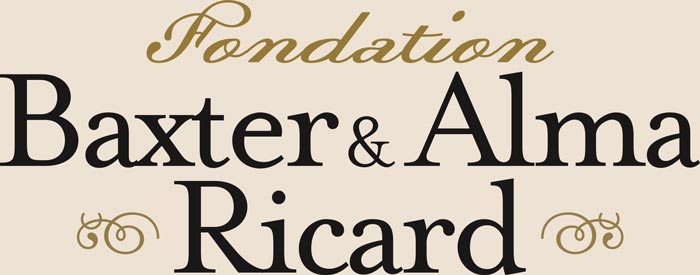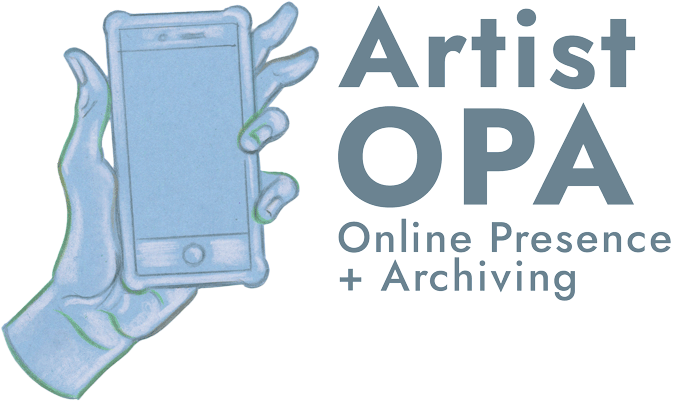D.8 Countering Narratives of Resource Extraction
D.8 Contrer les récits d’extraction des ressources
Fri Oct 20 / 15:15 – 17:00 / KC 210
chair / présidente /
- Laure Bourgault, Université du Québec à Montréal
This panel aims to look critically at the culture of resource extraction (natural, human, or else), and its ties with settler colonial projects. We are interested in approaches that engage with the energy imaginary through art, interdisciplinary, collaborative and embodied practices (performance, sound art, tours) or with a visual focus. What tools can offer these practices to counter extractive industries; what can we learn by looking at the visual culture associated with them? We seek contributions that critically reflect on—but are not limited to—the nationalist fetishization of infrastructures, the in/visibility of environmental toxicity, and the legacy of the industrial sublime; contributions that foster Indigenous and non-Western perspectives on energy, and/or work towards increased settler accountability.
Ce panel a pour objectif d’interroger de façon critique la culture liée à l’extraction des ressources (naturelles, humaines ou autres) et ses liens avec les projets du colonialisme de peuplement. Nous sommes intéressé∙es par les approches qui abordent l’imaginaire de l’énergie par l’art, par des pratiques interdisciplinaires, collaboratives et incarnées (performance, art sonore, marches) ou dans une perspective visuelle. Quels outils ces pratiques peuvent-elles offrir pour contrer les industries extractives; que pouvons-nous apprendre de la culture visuelle qui leur est associée? Nous sollicitons des contributions qui posent un regard critique sur la fétichisation nationaliste des infrastructures, sur l’in/visibilité de la toxicité environnementale ou sur l’héritage du sublime industriel, sans s’y limiter; des contributions qui valorisent des perspectives autochtones et non occidentales sur l’énergie, et/ou qui prônent une plus grande responsabilisation des colon∙isatrices.
keywords / mots clés: resource extraction, energy humanities, anti-colonial methodologies / extraction des ressources, humanités énergétiques, méthodologies anti-coloniales
session type / type de séance: panel / réunion d'experts
Laure Bourgault (she/her) is an artist, editor, and PhD student in the Interuniversity Program in Art History at Université du Québec à Montréal, Concordia, and Université de Montréal. Her research focuses on Quebec hydroelectric networks as aesthetic, mediated, political, material and legal objects. Envisioning the dam as a form of temporal/historical inscription, her work looks at the potential of images (media, artistic, documentary, and technical) to resist territorial dispossession, environmental extractivism, and act as tools in collective organization, speculative strategies, and legal recognition processes. She is a recipient of Luc-d’Iberville-Moreau and FRQSC doctoral scholarships. Since 2018, she co-edits Cigale, a bilingual publishing platform dedicated to experimental, documentary and critical writing (Sovereignties, 2022; Displacements, 2020; Working Body, 2019).
Seeing Through Oil: Photography and Land Relations in the Athabasca Tar Sands
- Siobhan Angus, Carleton University
Pushing against the emphasis on light and immateriality in photographic discourse, my presentation explores the material links between photography and mining. Considering what histories surface when photography begins underground, I center labor, settler colonialism, and environmental degradation to analyze photography’s imbrication in global extractive capitalism. Taking as a case study Warren Cariou’s petrographs of the Athabasca tar sands in Western Canada, this presentation focuses on images made with bitumen, the light sensitive material in the first photograph taken by Nicéphore Niépce in 1826. Cariou, an artist and academic of Métis and European descent, replicates a labor-intensive early photographic process, heliography, to create photographs made with oil from the tar sands. The bitumen is fixed on the surface of a polished metal plate, where it registers a material trace of extraction. I use bitumen to reorient photographic discourse from light to minerals, considering the complex interplay between time, fossils, solarity, and labor that bitumen introduces. I read Cariou’s work through Max Liboiron’s Pollution is Colonialism (2021) which shows that toxicity is a problem of settler colonial land relations, situating studies of toxicity within histories of land use. Large scale pollution is rooted in specific systems linked to the settler colonial project including industrialization, economic growth, and capitalism. In contrast, “different Land relations” exist in opposition to the colonial logics that cause pollution, relations that are “specific, place-based, and attend to obligations” (Liboiron 2021, 7). I argue that Cariou’s petrographs move toward a land-based photography, bringing into view the complex networks of settler colonialism, petro-capitalism, and consumption that make the image possible while proposing other ways of seeing human relations with territory. In doing so, Cariou makes a case for vision as a crucial site of anti-extractive worldmaking.
keywords: photography, extraction, settler colonial studies, Canada
Siobhan Angus is an art historian, curator, and organizer. Specializing in the history of photography and the environmental humanities, her current research explores the visual culture of resource extraction with a focus on materiality, labor, and environmental justice. She is an assistant professor of Media Studies at Carleton University and holds a Ph.D. in Art History and Visual Culture from York University where her dissertation was awarded the Governor General’s Gold Medal. Her research has been published in Panorama: Journal of the Association of Historians of American Art, Radical History Review, Capitalism and the Camera (Verso, 2021). Her book, Camera Geologica, is forthcoming with Duke University Press. At the heart of her research program lies an intellectual and political commitment to environmental, economic, and social justice.
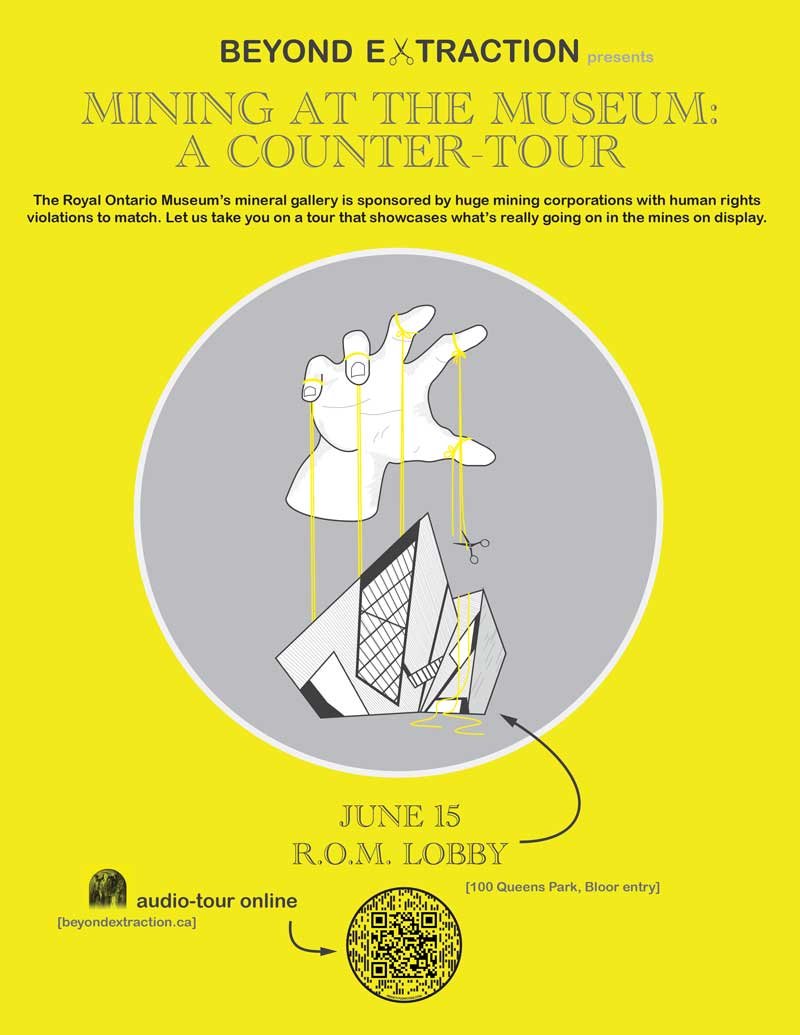
Mining at the Museum ROM Counter Tour Map, 2022, Beyond Extraction
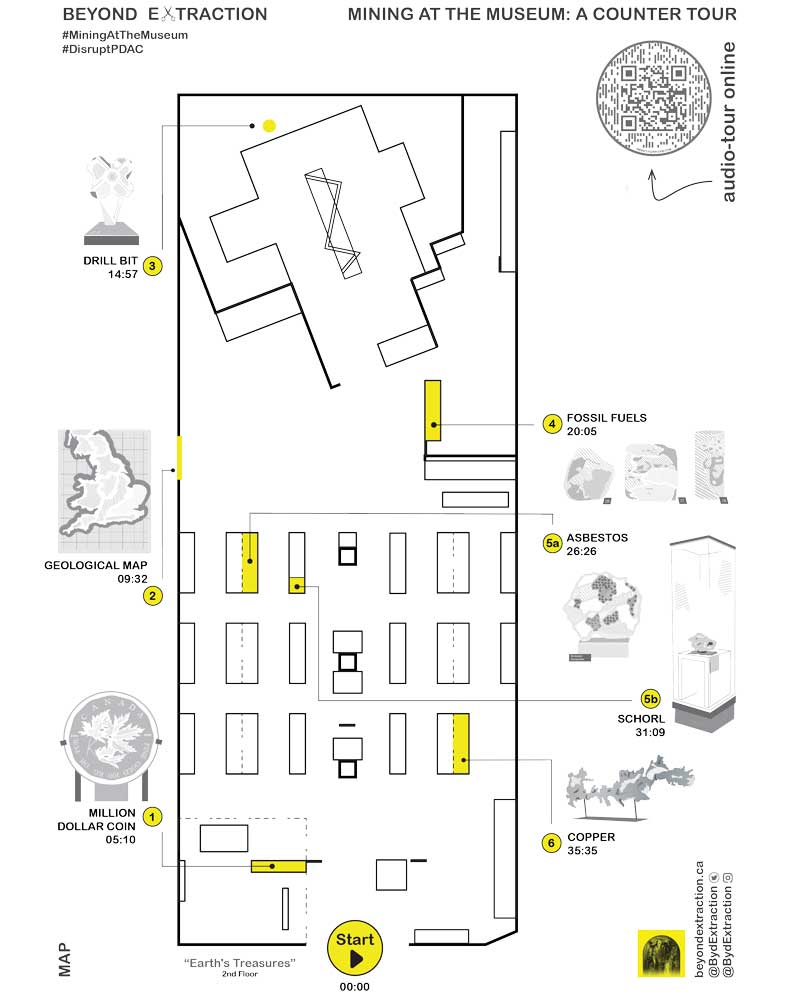
Mining at the Museum ROM Counter Tour Poster, 2022, Beyond Extraction

In-Person Launch of the ROM counter-tour, 2022, photo by Zannah Matson
Creative Counter-Pedagogies in Canada’s Mining Capital
- Camille-Mary Sharp, New York University
- Zannah Matson, University of Guelph
Every Spring in Toronto, Ontario, the world’s largest mining convention – the Prospectors and Developers Association of Canada (PDAC) – brings together global mining stakeholders and re-affirms the city as Canada’s centre for mining finance. Since the early 2000s, community delegations from around the globe have attended PDAC to disrupt the convention by sharing stories of the environmental and social degradation caused by largely unregulated Canadian mining operations. More recently, activists and scholars based in Canada have turned their attention to the ways in which PDAC works to shape narratives about the mining industry in the country year-round through influence on school curricula and museum exhibitions. The visual culture of PDAC’s educational efforts extend beyond Canadian classrooms, reaching young children and adults alike. Funding from PDAC and its educational arm Mining Matters is used to create everything from colouring books in classrooms to the curation and programming of the Royal Ontario Museum’s mineral exhibition.
In response to the visual culture that is funded by PDAC and distributed in public Canadian schools and museums, the scholar-activist collective Beyond Extraction has begun to develop counter-pedagogical tools designed to disrupt the grip that Canada’s mining industry has on culture and education in the country. In this session, two members of the collective, Zannah Matson and Camille-Mary Sharp discuss recent creative interventions of the collective, including a web-based, audio counter-tour of the ROM’s mineral gallery and an in-progress colouring book that seeks to subvert the educational agenda of PDAC.
keywords: counter-pedagogies, museums, extraction, PDAC
Camille-Mary Sharp is a researcher and educator specializing in the links between museums and resource extraction. She currently holds a Faculty Fellowship at New York University in the Program in Museum Studies, where she teaches courses on museum theory and museum activism. Camille-Mary’s ongoing speaking and writing projects focus on museum funding and social and environmental museologies.
Zannah Mae Matson’s research and design work focuses on the histories and contemporary reinterpretations of landscapes throughout processes of colonization, violence, and state infrastructure projects. Zannah is an Assistant Professor of Landscape Architecture at the University of Guelph School of Environmental Design and Rural Development and an active member of the Beyond Extraction Collective, a scholar-activist-led collective that mobilizes counter-extractive knowledges.
Du divertissement au divestissement : couper les liens entre les institutions artistiques et les industries extractivistes
- Edith Brunette, Université d’Ottawa, École d’études politiques
En 2016, j’ai participé à une résidence de recherche au Banff Centre, intitulé BRIC : On Energy. Elle rassemblait une vingtaine de chercheur.euses et d’artistes travaillant sur des sujets et enjeux liés aux énergies non-renouvelable, dans une perspective largement critique. À mi-parcours de la résidence, chacun.e d’entre-nous a reçu une demande de la part du Banff Centre d’adresser une lettre de remerciement à un.e donateur.ice de l’institution. À notre grande surprise, plusieurs d’entre nous avions été jumelé.e.s à une entreprise d’extraction pétrolière, gazière ou minière, notamment l’albertaine Husky Energy. Après discussion, notre cohorte a pris la décision de contacter les administrateurs.ices du Banff Centre pour leur faire part de notre malaise face à ce qui nous apparaissait comme une parfaite incohérence intellectuelle et éthique.
Le déploiement de la conférence de l’UAAC-AAUC au même Banff Centre représente une occasion de revenir sur cet incident, symptomatique des liens entre les milieux de l’art professionnel et les capitaux qui les financent. En Alberta, en particulier, ceux-ci sont indissociables de l’industrie des sables bitumineux et autres sources d’énergie sale. Le Canada, quatrième pays producteur de pétrole, n’échappe pas à cette problématique, alors que l’exploitation de ces ressources se fait le plus souvent aux détriments des communautés autochtones et sans leur consentement. J’examinerai, dans un premier temps, les enjeux structuraux qui favorisent ces relations problématiques, et ceux qui en découlent, ainsi que les stratégies que notre cohorte a adopté pour éviter d’y collaborer (trop) activement. J’interrogerai les limites de ces stratégies, emblématiques d’une attitude de compromis largement acceptée par les acteurs.ices des milieux artistiques canadiens. Dans un deuxième temps, je comparerai cette attitude et ces stratégies avec certaines pratiques, beaucoup plus retentissantes, de militantisme de divestissement (divesting protest), dont on retrouve peu d’exemples visant le soutien des énergies fossiles aux institutions canadiennes. Ces exemples nous servirons à alimenter une réflexion sur les possibilité d’un réel activisme contre l’exploitation des énergies fossiles, dans les milieux artistiques professionnels canadiens.
mots clés: divestissement, financement des institutions culturelles, industrie pétrolière et gazière
Artiste, autrice et chercheuse, Edith Brunette s’intéresse aux discours qui forgent et défont les pouvoirs, ainsi qu’à l’éventail des modes d’engagement politique—en particulier dans le champ de l’art. Cultivant des formes collectives de pratiques, ses projets récents ont notamment porté sur l’ethos entrepreneuriale, l’agentivité politique des artistes et la prise de parole en période de crise sociale. Ils ont été présentés dans de multiples galeries et centre d’art au Canada. Cofondatrice de l’organisation militante Journée sans culture, elle a coédité diverses publications à l’intersection de l’art et du politique (Aller à, faire avec, passer pareil, 2021 ; Troubler la fête, rallumer la joie!, 2017 ; Le Merle, 2015, 2017), en plus de contribuer comme autrice à différentes revues et livres sur l’art. Candidate au doctorat en études politiques à l’Université d’Ottawa, elle est récipiendaire des bourses de la Fondation Pierre-Elliott Trudeau (2019) et J.-A. Bombardier du CRSH (2018).
Artist, writer and researcher, Edith Brunette is interested in the discourses that shape and undo power, as well as political engagement across the spectrum—in particular with the field of art. Cultivating collective forms of practice, her recent projects have notably focused on entrepreneurial ethos, the political agency of artists and the act of speaking out in periods of social crises. Cofounder of the activist organization Journée sans culture, she has co-edited numerous publications at the intersection of art and politics (Aller à, faire avec, passer pareil, 2021; To Spoil the Party, To Set Our Joy Ablaze, 2017; Le Merle, 2015, 2017), as well as contributed to various magazines and books on art. A doctoral candidate in political science at the University of Ottawa, she is the recipient of funding from the Pierre Elliott Trudeau Foundation (2019) and the Social Sciences and Humanities Research Council of Canada’s Joseph-Armand Bombardier Canada Graduate Scholarship (2018).
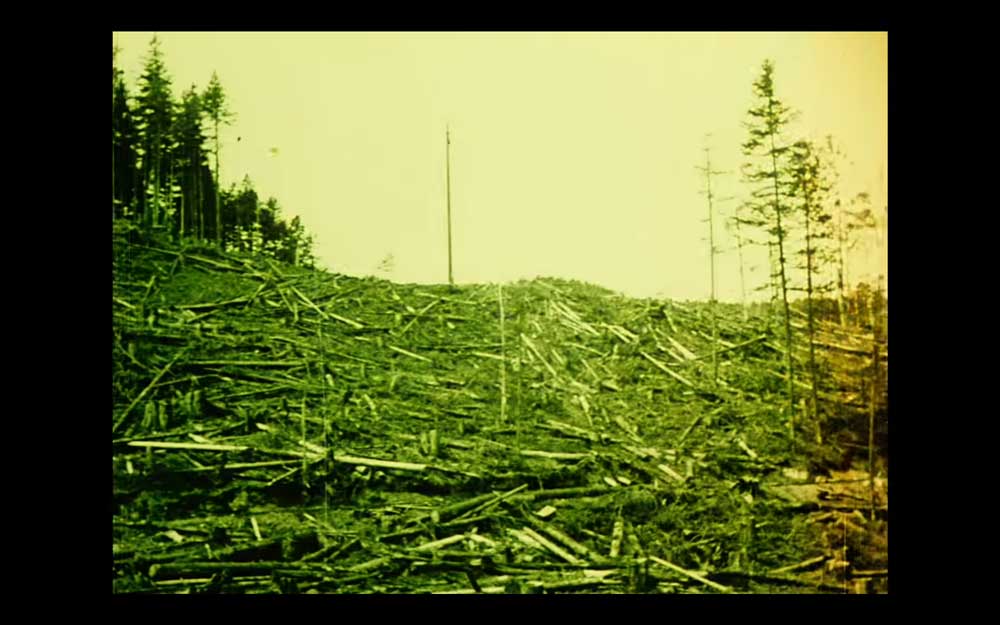
A Typical British Columbia Logging Operation (Vancouver Motion Pictures,1929) film still showing industrial logging on Vancouver Island
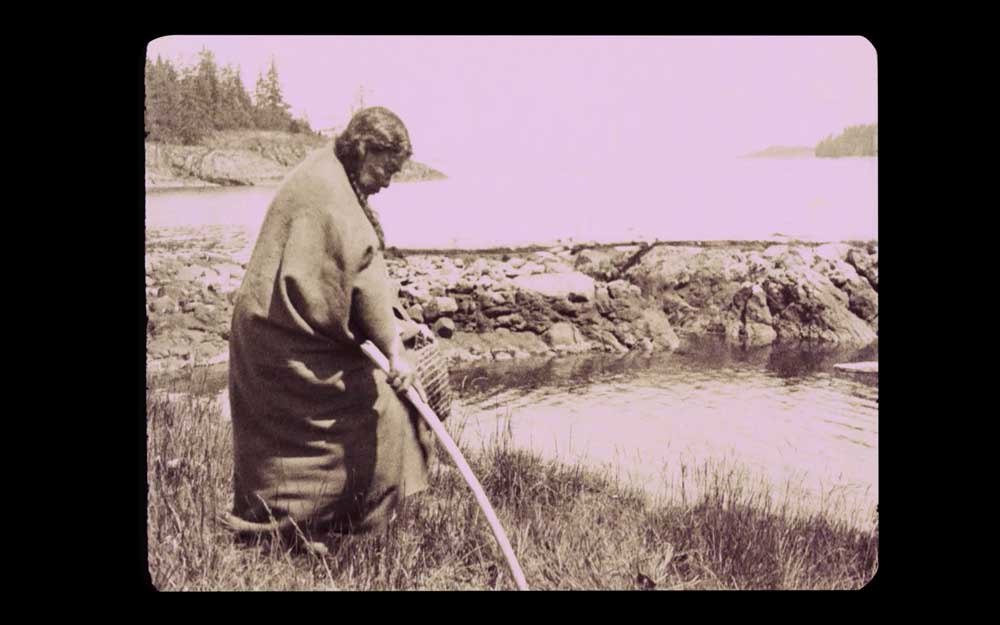
Totem Land (Associated Screen News, 1927) film still showing Tsukwani in her garden
Extraction and Survivance: Reimagining 1920s Extraction Cinema in the Indigenous Counter Archive
- Joseph Clark, Simon Fraser University
In the 1920s, Canadian cinema was extraction cinema. At a time when the Canadian feature film industry was all but dead, the field of industrial and sponsored film thrived – funded by government agencies and corporations looking to document and promote the exploitation of the country’s natural resources.
This paper considers two such films: A Typical British Columbia Logging Operation (1929), produced by Vancouver Motion Pictures for the Thomsen and Clark Timber Company and Totem Land (1927), produced by Associated Screen News for the Canadian Pacific Railroad. Both films aestheticize and spatialize the forests of British Columbia. By combining the motifs of industrial process films with the travelogue and ethnography, these films construct BCs forests as an industrial sublime, picturesque landscape, and site of the so-called “vanishing Indian.”
Drawing on the work of Priya Jaikumar and her notion of “filmed space,” the first part of my paper demonstrates how the filmed landscapes – both on screen and profilmic – were “instrumental in the sense that they [were] shaped by state and institutional power, aesthetic and narrative regimes, market forces, and social hierarchies.” It was through this aestheticization of space that extraction cinema of the 1920s linked white supremacy to deforestation.
But extraction cinema did not simply erase Indigenous peoples from the screen or the land. Indeed, Totem Land was made with the cooperation and participation of the Kwagu’ł people. Drawing on my own collaboration with Tom Child, N̓a̱msg̱a̱mk̓ala, (Kwagu’ł First Nation), the second half of my paper discusses the recent repatriation of Totem Land and other ethnographic films to the Kwagu’ł people and the ways in which Child and others view such films. Reading counter-archivally, Child sees a very different filmed space – one shaped not by the extraction logic of white supremacy, but a landscape shaped by – and home to – Indigenous survivance.
keywords: extraction cinema, industrial film, visual sovereignty, survivance, counter archive
Joseph Clark is a scholar, teacher, and filmmaker living on the unceded territory of the xʷməθkwəy̓əm (Musqueam), Skwxwú7mesh (Squamish), and Səl̓ílwətaɬ (Tsleil-Waututh) Nations. A Term Assistant Professor in the School for the Contemporary Arts at Simon Fraser University, his research, teaching, and creative practice focus on archival and non-theatrical media, including newsreels, home movies, and sponsored film. He is the author of News Parade: The American Newsreel and the World as Spectacle (University of Minnesota Press, 2020) and is currently working on a book on extraction cinema and the aesthetics of the forestry industry of the Pacific Northwest. His short film, Persistence and Loss (2021)—dealing with cinema, memory, and deforestation—has screened at the Small File Media Festival, Antimatter [Media Art], and as part of the Festival of (In)Appropriation sponsored by the Los Angeles Film Forum.
